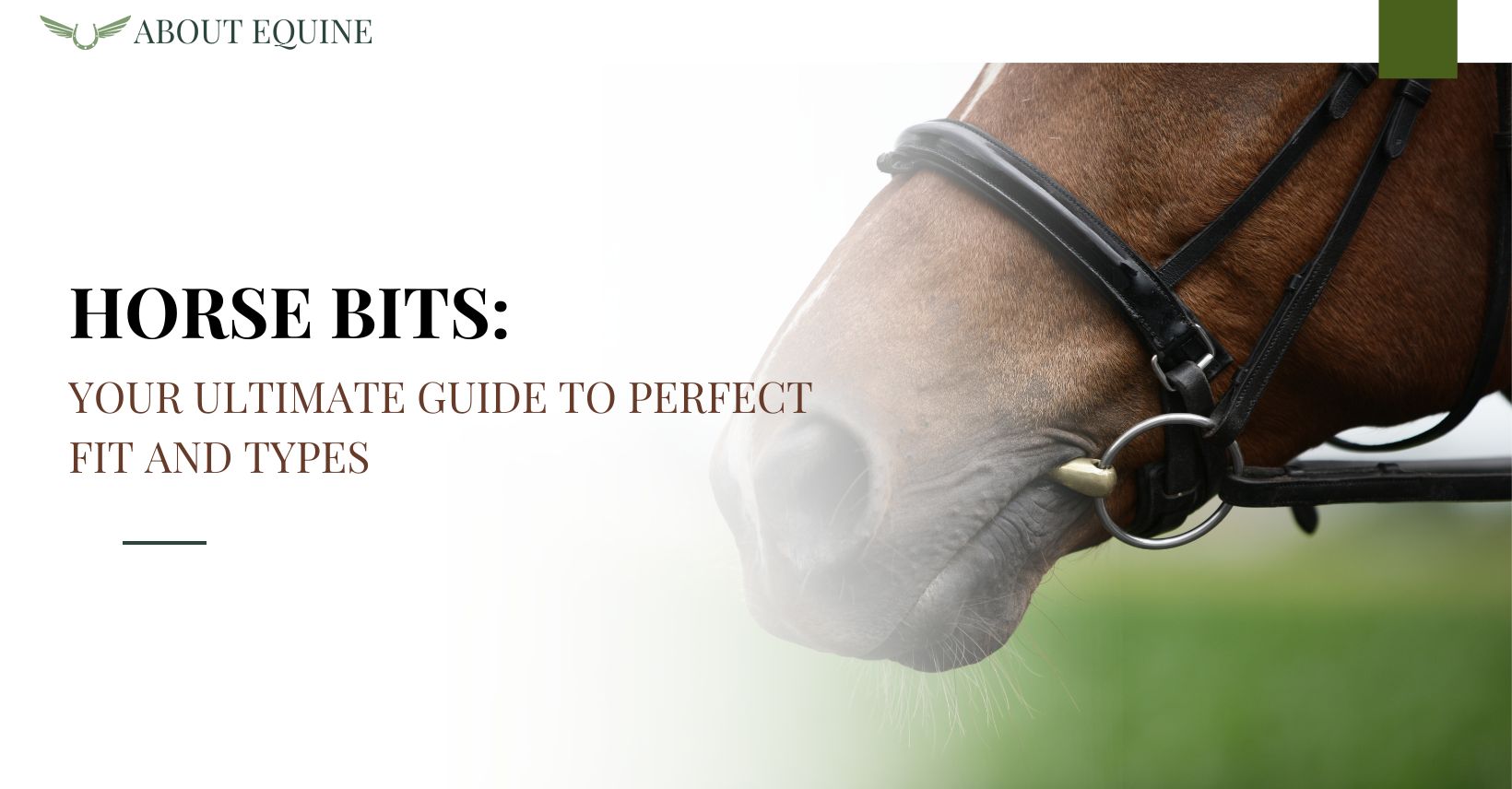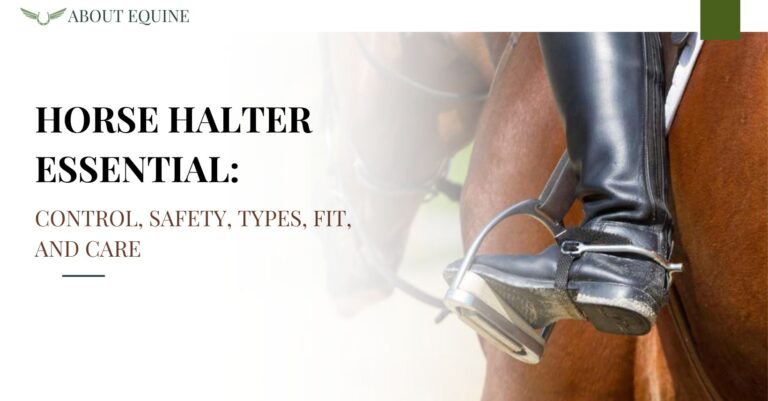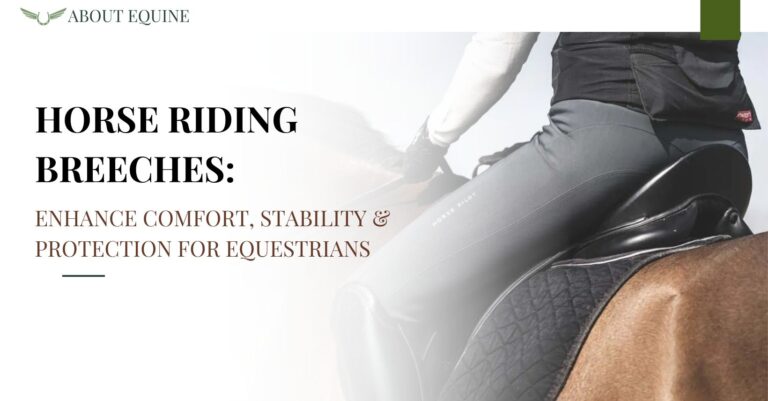Horse Bits: Your Ultimate Guide to Perfect Fit and Types
You are looking for the perfect fit for your horse regarding horse bits?
Explore the horse bits, including snaffle, curb, gag, pelham, and hackamore bits.
Learn how to measure your horse for the perfect fit and find the right bit for your horse at local tack shops, online retailers, custom bit makers, or through secondhand options.
When choosing a horse bit, consider factors such as your horse’s mouth shape and size, your rider experience, and your horse’s training and discipline. Make the right choice for your beloved equine companion!
What Are Horse Bits?
Horse bits are vital tools for communication between rider and horse. Designed to fit the horse’s mouth, they provide instructions through rein pressure.
Originating centuries ago, horse bits evolved from basic bone or leather tools to sophisticated metal designs, enhancing control and communication.
Different cultures created unique bits suited to their riding practices and needs. Today, horse bits are important in training and performance. They allow riders to convey subtle cues and commands, strengthening their bond with the horse. Advanced materials and designs offer various options for different disciplines and horse preferences.
Proper fitting and sizing of bits are essential for the horse’s comfort and responsiveness. Ill-fitting bits can cause discomfort and impede communication, affecting the horse’s performance and well-being. Ensuring a good fit promotes effective communication and a harmonious partnership. This highlights the importance of considering all factors when choosing the right equipment for your horse, which we will delve into further.
Why is it Important to Find the Perfect Fit for Your Horse?
Finding the right fit for your horse’s bit is essential for comfort, effective communication, and top performance. A properly fitted bit minimises the risk of discomfort or injury to the horse’s mouth. When the bit fits well, it rests easily in the horse’s mouth, enabling the rider to give subtle cues.
Discomfort can lead to behavioural problems, resistance, or evasion from the horse. An ill-fitting bit, on the other hand, can cause significant pain, resulting in physical harm and reluctance to follow commands.
Matching the bit’s size and thickness to the horse’s mouth anatomy is critical. Each horse is different, so factors like mouth size, shape, and sensitivity must be considered when choosing the right bit. Comprehending these factors helps you make the best choice. With these considerations in mind, analysing the various options available can help you find the perfect match for your horse’s needs.
What Are the Different Types of Horse Bits?
Horse bits come in various types designed for different purposes and levels of control. These include snaffle bits, curb bits, gag bits, pelham bits, and hackamore bits.
Snaffle bits are commonly used for young or green horses due to their gentle action on the horse’s mouth. They consist of a jointed mouthpiece that is applied directly to pressure on the corners of the mouth. Curb bits, on the other hand, have a lever action and work on pressure points in the poll and chin groove. They are suitable for more experienced horses.
Gag bits provide leverage and help tune up a horse that tends to lean on the bit. Pelham bits offer snaffle and curb actions, making them versatile for different situations. Hackamores, unlike bits, use pressure on the nose and chin for control and are ideal for sensitive horses or those with dental issues.
Snaffle Bits
Snaffle bits are commonly used in horse riding and have a jointed or double-jointed design. These bits exert direct pressure on the corners of the horse’s mouth.
When a rider applies pressure to the reins, the snaffle bit squeezes the horse’s mouth. This pressure helps signal the horse to slow down, stop, or change direction. The design of the snaffle bit allows for clear and precise communication between the rider and the horse. The shape and anatomy of the snaffle bit play a vital role in ensuring the comfort and safety of the horse. By fitting properly in the horse’s mouth, the bit reduces the risk of causing any injuries or discomfort.
Different riding disciplines, such as dressage, showjumping, and trail riding, may require specific snaffle bits to achieve optimal performance and communication with the horse. Riders must carefully consider the type of snaffle bit based on the discipline, the horse’s training level, and mouth sensitivity.
Curb Bits
Curb bits provide leverage and are commonly used for advanced training and disciplines. These bits have shanks that apply pressure to the horse’s chin and poll.
Proper fitting and sizing curb bits are required to communicate effectively between the rider and the horse. Ill-fitted bits can cause discomfort and hinder communication signals, leading to confusion and potential behavioural issues. Ensuring that the curb bit sits correctly in the horse’s mouth, with enough space for the tongue and no pinching or rubbing against the cheeks or corners, is essential.
Training techniques with curb bits vary based on the rider’s goals and the horse’s level of responsiveness. Riders must be skilled in applying subtle cues and releases to convey signals effectively. Consistent and clear communication through proper rein aids and pressure distribution helps the horse understand and respond appropriately to commands. Curb bits can also refine a horse’s movements in disciplines like dressage by enhancing collection and engagement.
Gag Bits
Gag bits are designed to provide additional control and action for riders in specific disciplines. These bits create leverage by sliding up and down on the bridle cheeks.
One of the unique features of gag bits is their ability to engage poll pressure, aiding in bending and flexion for more precise manoeuvres. In disciplines like show jumping and eventing, where split-second decisions are required, gag bits enable quick and clear communication between horse and rider. Riders can use subtle rein aids to refine their cues, helping develop a responsive and agile horse. Training methods such as half-halts and transitions complement gag bits, facilitating the refinement of the horse’s responsiveness to lighter aids.
Pelham Bits
Pelham bits combine elements of both snaffle and curb bits, offering riders dual rein options for training and control. These bits provide a versatile solution for various riding styles.
By incorporating direct and leverage action, pelham bits allow riders to communicate nuanced signals to the horse. A rider can decide between using the snaffle rein for direct cues and the curb rein for additional leverage. This adaptability is advantageous for schooling young horses as it enables the rider to introduce more advanced aids gradually.
When using pelham bits to prevent conflicting signals, riders must maintain consistent and sensitive hands. The design of pelham bits also encourages the horse to yield vertically and flex laterally, aiding in the development of suppleness and collection.
Hackamore Bits
Hackamore bits are bitless alternatives, so a noseband or chinstrap is used for communication and control. Riders often choose these for sensitive horses or gentler aids.
Their innovative design ensures a natural form of communication between horse and rider. These bitless solutions provide greater comfort and trust without the discomfort of a metal bit.
Hackamores respond sensitively to subtle cues, enhancing the bond and connection during training. Their versatility suits various disciplines, from Western riding to trail riding.
Understanding the advantages of hackamore bits is essential for ensuring your horse’s comfort and performance. The next steps involve precise measurements for those looking to achieve an optimal fit.
How to Measure Your Horse for the Perfect Bit Fit?
Measuring your horse correctly is essential to ensure the perfect fit for a bit. This process involves measuring the horse’s mouth, cheeks, and shank to determine the appropriate size and type of bit.
When measuring the mouth for bit width, use a soft measuring tape to wrap around the horse’s mouth where the bit will sit comfortably. Measure with enough slack for the bit to move without causing discomfort.
Similarly, measuring the cheeks is important for bit stability. Check the distance from the corner of the horse’s mouth to the top of their head to ensure the bit doesn’t pinch or slide around excessively.
Shank measurements are important in selecting the right bit for your horse. A longer shank can provide more leverage, while a shorter shank offers gentler cues.
Measuring the Mouth
Measuring the horse’s mouth is important for determining the correct bit width and ensuring comfort during riding. Selecting a bit that fits snugly but does not cause discomfort requires precision.
One way to measure the width of a horse’s mouth accurately is to use a soft measuring tape or a piece of string. Wrap the tape or string around the horse’s mouth where the bit would sit, ensuring it’s neither too tight nor loose. Once you have the measurement, compare it to the sizing chart provided by the bit manufacturer for an appropriate fit. An accurately sized bit can greatly impact the horse’s behaviour, allowing for better communication between the rider and the horse.
Measuring the Cheeks
Measuring the horse’s cheeks helps determine the bit’s stability and placement for effective communication. Proper measurements ensure that the bit exerts pressure correctly without causing discomfort.
Accurate cheek measurements are important as they directly impact the rider’s ability to communicate with the horse. When the bit is positioned correctly based on these measurements, the rider can have better control over the horse’s movements and responses. This precise fit minimises the risk of unnecessary discomfort or potential injuries to the horse’s sensitive facial structures. Ensuring that the bit is not too loose or tight on the cheeks greatly enhances the overall riding experience for both horse and rider.
Measuring the Shank
Measuring the shank of a bit is essential for understanding its leverage and its fit for training needs. Shank measurements determine the bit’s action and how it affects the rider’s aids. The length of the shank can vary the pressure on the horse’s mouth, altering its reaction to cues.
A shorter shank provides less leverage, is gentler on the horse, and is ideal for young or sensitive horses or riders preferring subtle cues. Conversely, a longer shank offers more leverage, enhancing signals to the horse’s mouth, and is useful for experienced riders needing precise communication or dealing with strong horses. The correct shank size is vital for effective communication and the horse’s comfort, especially for the perfect fit for your horse.
Where Can You Find the Perfect Fit for Your Horse?
Finding the perfect fit for your horse can be achieved through various sources such as local tack shops, online retailers, custom bit makers, or exploring secondhand options.
Custom-made bits offer the advantage of customising the design to your specific requirements, ensuring optimal comfort and control for your horse.
Online purchases provide convenience, allowing you to browse a wide selection from the comfort of your home, compare specifications, and read reviews before deciding.
Secondhand options can be cost-effective, offering quality bits at a lower price. Still, it’s important to carefully inspect them for any defects or signs of wear that could affect performance.
When selecting the right fit, consider material, design, size, and style based on your horse’s temperament, discipline, and individual needs.
Local Tack Shops
Local saddlery shops offer the advantage of in-person fittings and expert advice on selecting the right bit for your horse. These establishments provide hands-on experience in assessing bit quality and fit.
When you walk into a local saddlery shop, you are greeted by knowledgeable staff who understand the nuances of horse anatomy and rider preferences.
Their expertise allows them to recommend the most suitable options for your needs. This personalised service is unparalleled in its benefits, as it ensures that the bit not only fits correctly but also enhances your horse’s comfort and performance.
The commitment to quality assurance in local saddlery shops means you can trust the products you purchase. These establishments prioritise the horse’s well-being and the rider’s satisfaction, guaranteeing that every bit option meets the highest standards of craftsmanship and functionality.
Online Retailers
Online retailers offer convenience and a wide range of horse bits for purchase. Some platforms even provide virtual fittings to assist customers in selecting the right fit for their horses.
One key advantage of shopping for horse bits online is the accessibility it offers to riders and owners. Online platforms allow them to browse and purchase products from the comfort of their own homes. They also provide various options catering to riding styles and preferences. The availability of different brands and materials allows customers to explore and compare products before deciding.
Custom Bit Makers
Custom bit makers specialise in creating bespoke designs customised to individual horse and rider requirements. These artisans offer craftsmanship and attention to detail in producing unique and personalised bits.
Collaborating with these skilled artisans allows riders to design custom-made horse bits that are perfectly adjusted to their specific needs. By communicating their riding style and preferences, riders can work closely with the artisans to create a personalised piece that enhances communication and comfort between horse and rider.
The quality and craftsmanship associated with bespoke bit production ensure that each piece is meticulously crafted to the highest standards. Skilled artisans use premium materials and techniques to create durable and effective bits that cater to the unique requirements of both horse and rider.
Secondhand Options
Exploring secondhand options offers cost-effective ways to find quality horse bits that match your needs. A thorough quality check ensures the secondhand bit’s suitability. Purchasing a secondhand horse bit primarily saves costs.
Opting for a secondhand bit allows finding high-quality pieces at a fraction of the new price. Carefully inspect secondhand bits for wear, cracks, or damage that might compromise their effectiveness.
Understanding what makes a horse bit suitable can help you make the best choice, especially when considering key aspects like material, size, and design.
What Are the Factors to Consider When Choosing a Horse Bit?
Several factors influence the selection of a horse bit, including the horse’s mouth shape and size, the rider’s hands and experience, and the horse’s training and discipline.
When choosing a horse bit, it is important to consider how the bit interacts with the horse’s mouth anatomy. The size and shape of the mouthpiece, the type of cheeks, and the bit’s severity ensure comfort and effective communication between the horse and rider.
Properly matching the bit to the horse’s mouth anatomy is key to preventing discomfort and promoting a harmonious partnership.
Another vital factor to consider is the rider’s experience level. A skilled and delicate rider may require a lighter bit that allows for subtle cues. In contrast, a less experienced rider may benefit from a more straightforward, forgiving bit.
Horse’s Mouth Shape and Size
The shape and size of the horse’s mouth play a vital role in determining the most suitable bit. Properly fitting bits enhance comfort and performance while ensuring effective communication between the horse and the rider.
When selecting a bit for a horse, factors such as the mouth’s width, the palate’s shape, and the bars’ sensitivity must be considered. A bit too wide can cause discomfort and resistance while riding, while a bit too narrow can pinch the horse’s lips and create pain.
This is where the bit’s design and material come into play, with options such as double-jointed bits, mullen mouth bits, and ported bits providing different levels of pressure distribution and tongue relief.
Rider’s Hands and Experience
The rider’s hands and experience level influence the choice of a horse bit as they determine the pressure and communication style applied through the reins.
Experienced riders may opt for more nuanced bits to convey subtle cues. Their refined hand control allows them to communicate effectively with the horse, utilising minimal rein pressure for precise responses. These riders often prefer bits with multiple moving parts or different pressure points to provide varying signals.
On the other hand, novice riders might find simpler, straightforward bits more suitable. With less experience maintaining consistent and sensitive hand contact, they can benefit from bits that offer clearer feedback and are less severe in response to unintentional cues.
Horse’s Training and Discipline
The horse’s training level and discipline requirements dictate the bit type for effective communication and performance. Different training regimens may require specific bit designs or materials.
For instance, a horse in initial training may benefit from a simple snaffle bit that offers gentle cues and encourages responsiveness without overwhelming the horse. As the horse progresses and gains experience, a bit with leverage, like a curb bit, might be necessary for precise signals and refined communication.
In disciplines like dressage, where subtlety and precision are required, the type of bit chosen can greatly impact the horse’s performance. A well-fitted, appropriate bit helps maintain lightness in contact, collection, and harmony between rider and horse.
With these considerations in mind, it’s essential to weigh your options carefully to ensure the best choice for your horse’s needs and performance goals.
Making the Right Choice for Your Horse
Selecting the right horse bit ensures effective communication and comfort during riding sessions.
When choosing a horse bit, it’s essential to prioritise your equine companion’s well-being above all else. Finding a bit that fits correctly – not too loose or tight – is key to preventing discomfort and potential injury.
Consider the material quality also; opt for durable and safe materials that won’t harm your horse’s mouth. Look for design features like ergonomic shapes or special joints that can improve communication clarity and responsiveness. By understanding your horse’s specific needs and preferences, you can make an informed decision that benefits both of you in the long run.



